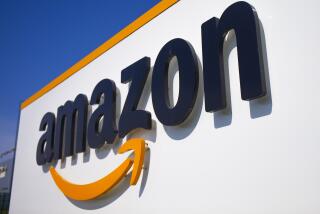Column: Xerox, once a business icon, is about to disappear — take heed, Amazon and Google
- Share via
It was not so long ago that one could count on certain familiar guideposts of business: Xerox was the dominant provider of office equipment, Sears the biggest retailer, General Electric the leading manufacturer of, well, almost everything, and you couldn’t take a photograph without Kodak.
This world is on the verge of major change. Xerox is about to disappear into Japan’s Fujifilm, its longtime joint venture partner in Fuji Xerox. The parent company of Sears, after years of declining sales, store closings, and generally disappearing presence in the marketplace, last year told investors that “substantial doubt exists” about its ability to survive. Since 2010, the company has shrunk from 3,500 Sears locations to fewer than 600.
General Electric is on the verge of getting kicked out of the 30-stock Dow Jones Industrial Average. That would be a cataclysmic change, since the company is the only survivor of the 12 stocks in the index when it originated in 1896.
They were all asking, ‘Where’s the click?’
— A Xerox PARC veteran recalls how its personal computer left the copier salesforce cold
All three companies once appeared to occupy impregnable positions in American business, and all are facing extinction. There’s nothing especially unusual about that, given the dynamism of business all over the world. But it’s a fact of life easily forgotten.
That’s a warning for today’s occupants of the business pinnacle, including Amazon, Google (that is, Alphabet), and Facebook. Competitive advantage is not a permanent gift. Indeed, the more successful a company is, the more unassailable its competitive position appears, the greater the forces that gather to knock it off its perch. As Morgan Housel of Collaborative Fund put it in a recent blog post, “Brands are hard to build and even harder to span across generations.”
That’s not the only factor in the decline of a dominant business. Some become so wealthy that they turn their efforts to maintaining their wealth instead of finding sources of new wealth. Some become convinced that the skills that brought them success the first time around are transferable to other markets, and take their eyes off the original ball (we’re looking at you, Elon Musk). Some run into technological changes that are simply too big for them to handle.
This shouldn’t come as a surprise to the masters of today’s business universe. After all, Amazon, Google, and Facebook each got where they are today by dislodging one or more precursors — before Google there was Yahoo, before Facebook there was Myspace, before Amazon there was a panoply of department store giants and big-box warehouse stores.
Every generation grows up with brand names that are dim memories by the time they reach maturity. Gone today, or at least withered, are such once-familiar brands as Howard Johnson’s restaurants, Smith Corona typewriters, Blockbuster Video and Tower Records, Polaroid and Kodak, F.W. Woolworth and Kresge (the latter, long ago rebranded as Kmart, now part of Sears Holdings). Aol.com last year assembled a photo gallery of disappeared and disappearing brands, yet somehow failed to include itself, a faint shadow of the company that once stood like a colossus over the internet as America Online.
Xerox is perhaps the best example of a company that became too big and successful to remake itself. It was said that the company had become a prisoner of the Chester Carlson legacy. That was a reference to the inventor of the machine that became the Model 914 copier, which upon its introduction in 1960 became the most successful industrial product in history.
The hulking 914 brought in stupendous revenue, in part because of the new business model it inspired. Customers could not buy a 914, but only lease it, paying Xerox by the page. Soon, the company had a worldwide sales force of close to 100,000, all of them accustomed to counting their income by the “click” of paper going through the machines they had placed in their clients’ central copying rooms.
The leasing idea was so successful that its inventor, Peter McColough, eventually was rewarded with the posts of chairman and CEO. McColough, however, was smart enough to perceive that his company’s dominance might not last forever. Copier technology was becoming miniaturized, which pointed to the development of desktop units. And there was no guarantee that paper would remain central to the office indefinitely. So in 1971 he ordered a corporate laboratory to be established as far from Xerox’s existing copier labs as possible—in far off California, where the Palo Alto Research Center, the legendary PARC, opened in a building that had recently been vacated by the Encyclopedia Britannica. Its new inhabitants were charged with inventing “the office of the future.”
So PARC’s young engineers and computer scientists invented the personal computer, the laser printer, and ethernet, but they could not get headquarters’ attention until a conference of the company’s worldwide sales force in 1977. At the so-called “Futures Day,” they demonstrated all they had achieved, only to face an uncomprehending response from the audience. “They were all asking, ‘Where’s the click?’” one former PARC engineer recalled.
McColough’s business model, on which a generation of salespersons had been trained, was now working against him. They couldn’t understand how they would earn commissions in a world without paper. The company eventually did bring out a personal computer based on PARC’s prototypical Alto.
The Star was a wonderful machine, with a high-quality graphical display and a level of software and hardware integration that would still be the envy of computer users today. But it was built and marketed on a Xerox scale—big, hulking units slid under every secretary’s desk with a terminal up top, priced at $16,500 per unit, or nearly $50,000 in today’s money. A full office installation could easily cost $250,000 or more, a much larger sum than the average office would invest to equip the secretarial pool (male executives in that era didn’t type, much less compute).
And within months of the Star’s introduction in 1981, the IBM PC arrived. The PC was a comparatively feeble machine--no graphics, no integrated programs--but its $2,000 price tag lowered the bar for office systems, permanently.
Xerox is regularly mocked for having missed the PC revolution. But that’s uncharitable. It may have looked impregnable in 1970, but it was already too big and too single-minded a ship to be turned around and refocused on an entirely new product serving a market that did not even exist yet. It’s a rare company that can remake itself to that degree while still enjoying the harvest of its original model. Much more frequently, a company rides a wave or two to wealth and prominence, and then succumbs to a new technology or marketing trend to which it can’t adjust.
IBM did manage to shift from big computers to desktop PCs. But it was already in the computer business, so the change was not nearly so massive. IBM only succeeded by hiving off its PC unit into an independent operation; even so, it eventually got out of the PC business by selling it to the Chinese company Lenovo. IBM once reigned as the champion phoenix of the technology industry, surviving wave after wave of elemental change; but even Big Blue has stumbled in recent years.
It’s always tempting to think of the future as the same as today, only more so. That’s why we imagine a future in which Amazon is the only name in retail and Google and Facebook control everything we read, hear and feel. Things have never worked out that way no matter how majestic are the kings of commerce at any given moment. Maybe these companies will grow so big and stay so smart that they’ll prevail over the forces that brought down their precursors. But that’s not a good bet.
Keep up to date with Michael Hiltzik. Follow @hiltzikm on Twitter, see his Facebook page, or email [email protected].
Return to Michael Hiltzik’s blog.
More to Read
Inside the business of entertainment
The Wide Shot brings you news, analysis and insights on everything from streaming wars to production — and what it all means for the future.
You may occasionally receive promotional content from the Los Angeles Times.











